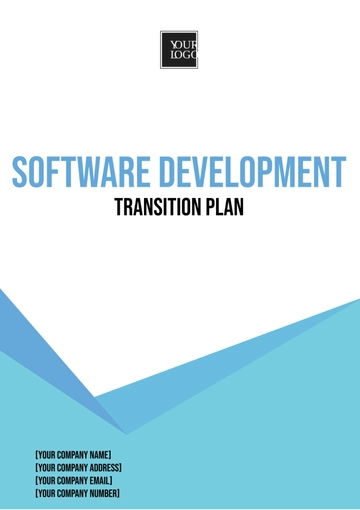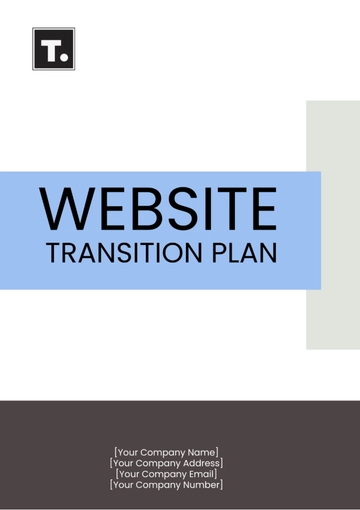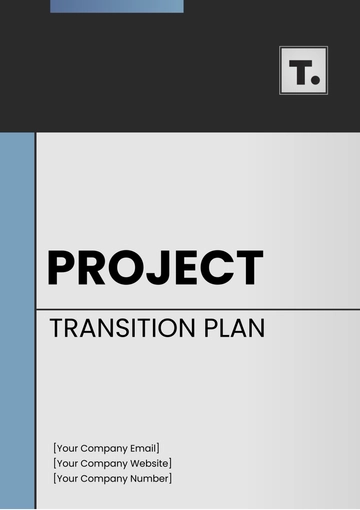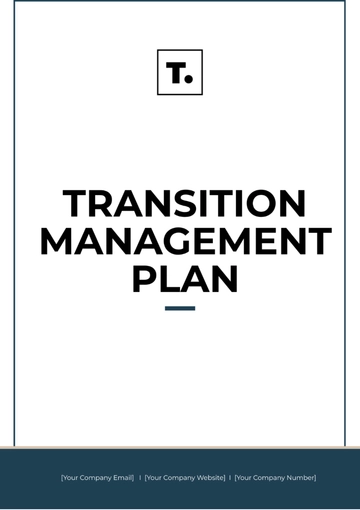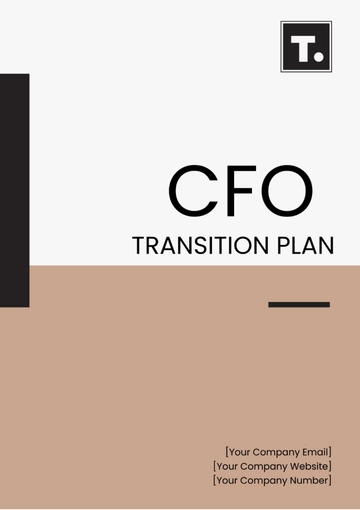Free Leadership Transition Plan

Written by: [Your Name]
Introduction:
Understanding the critical role that leadership transition plays in shaping the direction and success of an organization, [Company Name] has crafted a Transition Plan designed to facilitate a smooth and effective transfer of duties when a key executive retires, resigns, or is otherwise unable to fulfill their responsibilities. This strategy is essential for preserving stability, continuity, and operational efficiency during times of change in leadership.
A. Purpose:
This Transition Plan is designed to reduce interruptions caused by changes in essential leadership, ensuring continuous success by establishing distinct protocols and promoting an effortless shift. It encompasses the identification and readiness of prospective leaders, the creation of succession approaches via training and mentoring, the facilitation of knowledge sharing, and the preservation of stakeholder trust to maintain our reputation and stability.
B. Scope
This Transition Plan details the comprehensive process of leadership succession at our organization, from the selection of prospective leaders to their full integration into key positions. It encompasses identifying vital roles, crafting succession plans, passing on crucial knowledge, keeping stakeholders informed, and consistently reviewing and adjusting the plan to meet the organization's objectives.
II. Key Contacts
Contact Name | Role | Phone Number | |
|---|---|---|---|
[Contact Name 1] | Current Executive | [Email Address] | [Phone Number] |
[Contact Name 2] | Successor | [Email Address] | [Phone Number] |
III. Transition Team
[Contact Name 1] – Executive Sponsor
[Contact Name 2] – Transition Manager
[Contact Name 3] – HR Representative
[Contact Name 4] – Communications Lead
IV. Timeline
Major Milestones | Dates |
|---|---|
Announcement of Transition | [MM/DD/YYYY] |
Successor Training and Development | [MM/YYYY - MM/YYYY] |
Final Handoff | [MM/DD/YYYY] |
V. Training and Development:
Details | |
|---|---|
Leadership Training | The successor will participate in a tailored leadership training program covering strategic thinking, decision-making, communication, management, organizational leadership, change management, conflict resolution, and stakeholder engagement. |
Departmental Rotations | The successor will undergo rotations across key functional areas to gain insights into the organization's operations and foster cross-functional collaboration. |
Mentorship | The successor will be paired with a mentor for personalized guidance and support throughout their transition. |
Performance Reviews | Regular performance reviews and feedback sessions will be conducted to monitor progress and address development needs. |
VI. Communication Plan
Internal Communication
Initial Announcement:
Method and Timing: The leadership transition announcement will be made during an "All-Hands" meeting, scheduled for optimal attendance, to allow for real-time engagement and discussion.
Regular Updates:
Frequency and Method: Employees will be updated bi-weekly on the transition process via email, intranet, and town hall meetings to inform on progress, milestones, and plan changes.
Successor Introduction:
Introduction Strategy: The successor will be introduced to the organization via events and communications, including a "Meet the Successor" session and an internal profile shared through email and on the company intranet.
External Communication
Press Release:
Release Summary: A press release on the leadership change, highlighting the outgoing leader's impact, the new executive's credentials, and the firm's focus on stability and growth, will be issued to media and industry outlets and feature supportive quotes from board members and top executives.
Social Media Announcements:
Company Social Media Update: We will use platforms like LinkedIn, Twitter, and Facebook to announce our leadership transition. Posts will highlight our values, the new leader's strengths, and encourage followers to welcome them.
Customer and Partner Communication:
Customers and partners will be informed about the leadership change through personalized emails and website updates, highlighting the company's dedication to strong relationships and service continuity. The new leader will be introduced as the primary contact. Further details will be provided in newsletters, blog posts, and other digital platforms for broader awareness and transparency.
VII. Risk Management
Potential Risks:
Disruption in Leadership: Sudden executive departures may cause instability and hinder decision-making.
Loss of Key Knowledge: Exiting executives may take critical institutional knowledge with them.
Employee Morale: Uncertainty around transitions can lower morale and productivity.
Mitigation Strategies:
Create Knowledge Transfer Plan: Document processes and insights to ensure continuity.
Provide Interim Leadership Support: Appoint temporary leaders for stability.
Engage Employees through Regular Communication:
Maintain transparency and address concerns.
VIII. Evaluation and Monitoring
Success Metrics:
Seamlessness of Transition: Assess the transition process's effectiveness by monitoring milestone achievements, continuity of operations, and minimized disruptions.
Integration of Successor: Evaluate the successor's adaptation to their role, relationship-building, and leadership effectiveness.
Feedback from Stakeholders: Gather insights from various stakeholders to understand their perceptions of the transition and the successor's performance.
Ongoing Monitoring: Continuously evaluate progress, identify challenges, and adjust strategies as needed.
Regular Check-ins Post-transition: Schedule regular meetings to review progress, address concerns, and ensure alignment with organizational goals.
Continuous Feedback Collection: Establish mechanisms to gather ongoing feedback for improvement and adaptation.
IX. Conclusion
This Transition Plan is designed to ensure that continues to thrive despite changes in key leadership positions. By following this plan, we aim to maintain stability, safeguard organizational knowledge, and prioritize the well-being of our team and stakeholders.
- 100% Customizable, free editor
- Access 1 Million+ Templates, photo’s & graphics
- Download or share as a template
- Click and replace photos, graphics, text, backgrounds
- Resize, crop, AI write & more
- Access advanced editor
Streamline your company's leadership changes with the Leadership Transition Plan Template, offered by Template.net. This customizable, downloadable, and printable template ensures a smooth transition. Effortlessly editable in our AI Editor Tool, it allows you to tailor every detail to fit your organization’s needs. Optimize your transition strategy with this essential resource today.
You may also like
- Finance Plan
- Construction Plan
- Sales Plan
- Development Plan
- Career Plan
- Budget Plan
- HR Plan
- Education Plan
- Transition Plan
- Work Plan
- Training Plan
- Communication Plan
- Operation Plan
- Health And Safety Plan
- Strategy Plan
- Professional Development Plan
- Advertising Plan
- Risk Management Plan
- Restaurant Plan
- School Plan
- Nursing Home Patient Care Plan
- Nursing Care Plan
- Plan Event
- Startup Plan
- Social Media Plan
- Staffing Plan
- Annual Plan
- Content Plan
- Payment Plan
- Implementation Plan
- Hotel Plan
- Workout Plan
- Accounting Plan
- Campaign Plan
- Essay Plan
- 30 60 90 Day Plan
- Research Plan
- Recruitment Plan
- 90 Day Plan
- Quarterly Plan
- Emergency Plan
- 5 Year Plan
- Gym Plan
- Personal Plan
- IT and Software Plan
- Treatment Plan
- Real Estate Plan
- Law Firm Plan
- Healthcare Plan
- Improvement Plan
- Media Plan
- 5 Year Business Plan
- Learning Plan
- Marketing Campaign Plan
- Travel Agency Plan
- Cleaning Services Plan
- Interior Design Plan
- Performance Plan
- PR Plan
- Birth Plan
- Life Plan
- SEO Plan
- Disaster Recovery Plan
- Continuity Plan
- Launch Plan
- Legal Plan
- Behavior Plan
- Performance Improvement Plan
- Salon Plan
- Security Plan
- Security Management Plan
- Employee Development Plan
- Quality Plan
- Service Improvement Plan
- Growth Plan
- Incident Response Plan
- Basketball Plan
- Emergency Action Plan
- Product Launch Plan
- Spa Plan
- Employee Training Plan
- Data Analysis Plan
- Employee Action Plan
- Territory Plan
- Audit Plan
- Classroom Plan
- Activity Plan
- Parenting Plan
- Care Plan
- Project Execution Plan
- Exercise Plan
- Internship Plan
- Software Development Plan
- Continuous Improvement Plan
- Leave Plan
- 90 Day Sales Plan
- Advertising Agency Plan
- Employee Transition Plan
- Smart Action Plan
- Workplace Safety Plan
- Behavior Change Plan
- Contingency Plan
- Continuity of Operations Plan
- Health Plan
- Quality Control Plan
- Self Plan
- Sports Development Plan
- Change Management Plan
- Ecommerce Plan
- Personal Financial Plan
- Process Improvement Plan
- 30-60-90 Day Sales Plan
- Crisis Management Plan
- Engagement Plan
- Execution Plan
- Pandemic Plan
- Quality Assurance Plan
- Service Continuity Plan
- Agile Project Plan
- Fundraising Plan
- Job Transition Plan
- Asset Maintenance Plan
- Maintenance Plan
- Software Test Plan
- Staff Training and Development Plan
- 3 Year Plan
- Brand Activation Plan
- Release Plan
- Resource Plan
- Risk Mitigation Plan
- Teacher Plan
- 30 60 90 Day Plan for New Manager
- Food Safety Plan
- Food Truck Plan
- Hiring Plan
- Quality Management Plan
- Wellness Plan
- Behavior Intervention Plan
- Bonus Plan
- Investment Plan
- Maternity Leave Plan
- Pandemic Response Plan
- Succession Planning
- Coaching Plan
- Configuration Management Plan
- Remote Work Plan
- Self Care Plan
- Teaching Plan
- 100-Day Plan
- HACCP Plan
- Student Plan
- Sustainability Plan
- 30 60 90 Day Plan for Interview
- Access Plan
- Site Specific Safety Plan













